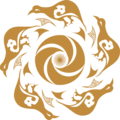The Modern Gallery was founded in 1902, its collection and exhibition activities focused on art of the 19th and 20th centuries. After Czechoslovakia gained independence in 1918, the Picture Gallery became the main institution of fine art collections. Under its modern name, the National Gallery Prague – which is the successor of the Art Gallery and the Modern Gallery – was formed in accordance with the law adopted in 1949. Now it is the most extensive collection of works of art in the Czech Republic.
In the late 19th century factory made fabrics were imported to Central Asia from Afghanistan, England and Russia. This resulted in colored backgrounds (red, yellowand violet) for embroideries. Sometimes silk was used for lining. Although the fabric and even the embroidery were made in a family setting, copies of the designs were ordered from experienced draftsmen.
Curtains in Uzbekistan rarely adorned walls in a way they did it in the West, and were used for that purpose only on holidays. Most often they covered niches in walls, functioning as the doors of built-in pieces of furniture, or separated a sleeping area in a common room. The traditional plan of the Uzbek house in the 19th – early 20th centuries and the functions of certain types of embroidery in its interior were described by Galyna Chepelevetskaya. The author emphasizes the decorative qualities of embroidery and notes that people aimed to cover the entire surface of the walls with these ornamental panels.
The wall located opposite the entrance had three niches. Clothes and bedding were stored in the two larger niches on the right and left. These niches were decorated with choyshab embroidered covers. The niche in the middle was used to store bed linen and was covered by kirpech embroidery. Sometimes the niches were different – with smaller niches on the right and left and a larger one in the center. Embroidered dorpech panels were placed under the ceiling, decorating like friezes the narrower walls of the room. The dorpech panels were connected to zebidevor (zardevor) panels stretched under the ceiling along the longer walls of the room. This, however, was not a full list of embroidered textiles used in the interior of the Uzbek house. Other traditional types of embroidered textiles were used for family celebrations and ceremonies, especially wedding parties, when they decorated the room for the newlyweds. There was a popular belief among people that the power of these textiles protected the newlyweds from the evil eye.
You can learn more about the topic in the book-album "The Collection of the Czech Republic" (Volume XVI) in the series "Cultural Legacy of Uzbekistan in the World Collections".
The main sponsor of the project is the oilfield services company Eriell-Group.

